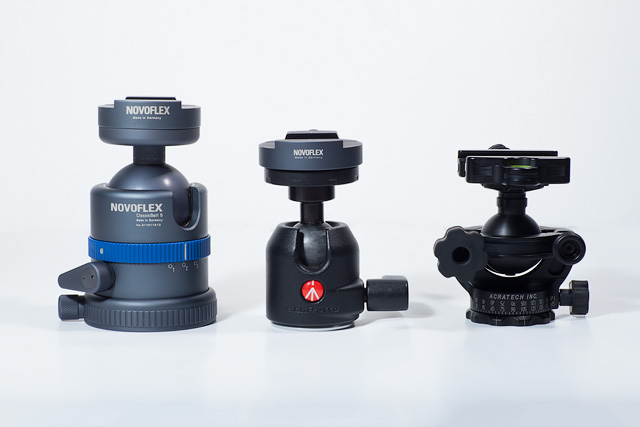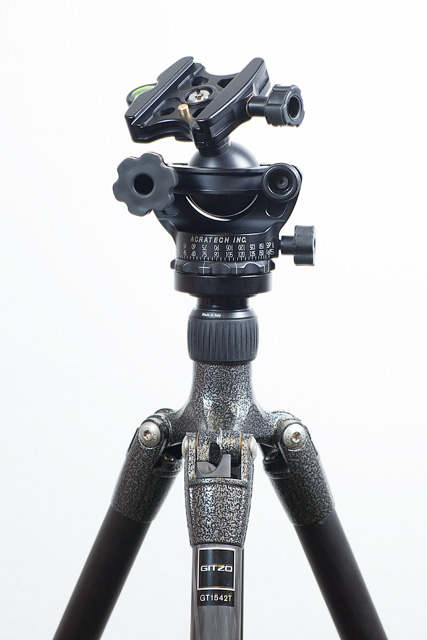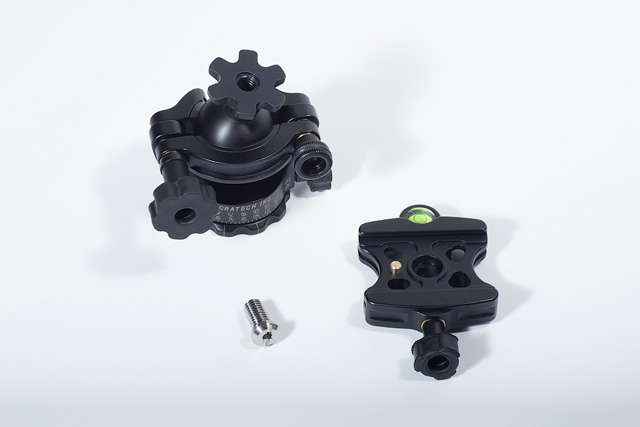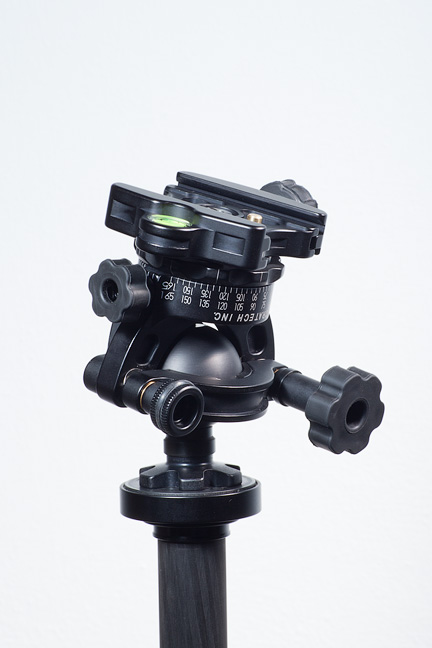equipment reviews
acratech gp-s ballhead
For my current lightweight tripod Gitzo 1542T Traveler Series 1 I needed a head that would be lightweight, too, and compact, and also usable for all genres of photography that I do during my trips, i.e. it had to be equally good for wildlife photography, for macro, for landscapes and even for panoramas. With my large Novoflex Quadropod (see Reviews: Novoflex Quadropod) I use a Novoflex Classic Ball 5 (see Reviews: Novoflex Classic Ball 5). If I am going to travel long and expect to encounter various subjects, i.e. am not sure which genre of nature photography it is going to be, I take with me all tripod gear that I may need. Thus, to use the Novoflex Classic Ball 5 as gimbal head, I need Wimberley SideKick, and I need a panorama plate to make it suitable for panorama photography. With the lightweight version of tripod that is now based on Gitzo 1542T (see Reviews: Gitzo 1542T Traveler Series 1) I also need the same functionality.
For use with the Traveler tripod, Gitzo recommends the compact and lightweight ball heads GH1781T or GH1781TQR. They have a similar construction, height and capacity as the Manfrotto 486 shown below and therefore aren't equivalent to Acratech GP-s. Like Manfrotto 486 these Gitzo heads have no friction adjustment mechanism, nor panoramic rotation; the head is fixated with a single lever. The ball is even smaller than in Manfrotto. Gitzo's compact head costs about twice as much as Manfrotto 486 but just half of the price of Acratech GP-s. Though I didn't have a chance to try a GH1781T head, its construction lets me think that it performs very similarly to the much cheaper Manfrotto 486 and that the only advantage of Gitzo's ballhead is it's shape that allows to take full advantage of small carrying size of the 1542T tripod.
Similar ball heads with single leveler construction — Novoflex BALL 30 and BALL 40, Novoflex MagicBall Mini, Freisol CB-30C have the same problems: no panning and no friction control. Some of them, such as MagicBall Mini and Ball 40 are also too wide and bulky.
In general, ball heads that have a single knob construction are too primitive for my needs — at least because they have no separate control of horizontal movement (panning). To use such a head for panoramas, I need to attach a separate panning plate to it. I tried to use Novoflex Panorama plate with the above mentioned Manfrotto head and, finally — with Novoflex MagicBalance. In both cases the construction was quite heavy and bulky and therefore didn't make much sense for use with such a compact tripod.
Therefore, I compared all ball head models of several manufacturers that are suitable for lightweight tripods. There results are shown in the following table.
| Acratech GP-s | Novoflex BALL 40 | Novoflex MagicBall Mini | Feisol CB-30C | Markins Q-Ball Q3 "Emille" | RRS BH-30 Pro | |
| Overall Height (mm) | 98 | 95 | 75 | 75 | 89 | 75 |
| Overall Body Width (mm) | 80 | ca. 60 | 110 | unknown | 48 | unknown |
| Ball Diameter (mm) | 38 | unknown | 40 | 30 | 38 | 30 |
| Base Diameter (mm) | 53 | 53 | 35 | unknown | 56 | 41 |
| Capacity (kg) | 11.3 | 10 | 5 | 8 | 30 | 6.8 |
| Weight (g) | 400 | 485 | 330 | 283 | 375 | 283 |
As you see, Markins Q-Ball Q3 "Emille" has the best characteristics. I don't believe however that its load capacity is so huge. It is a really piece of gear head that has features of a serious tripod had — friction control (even bi-axial) and panning. The panning rotation is, however, only around the base and not around the top of the head as in Acratech GP/GP-s. After GP-s, this head was my second candidate. The third was Really Right Stuff (RRS) BH-30 Pro — that also has both, friction control and panning, but also rotates only around the base. Finally, I made my decision in favour of Acratech GP-s. In the rest of this review I am going to explain why.
Recently, Acratech GP-s became the third member of my set of tripod heads that you see in the picture below.

My current ball heads compared — Novoflex Classic Ball 5, Manfrotto 486 Compact Ball Head (with Novoflex quick release plate), Acratech GP-s.
construction and function

Acratech GP-s on Gitzo 1542T Traveler Series 1 tripod.
The Acratech GP Ballhead is a remarkable product. Already its appearance is unparalleled and at once makes you wish to try it out. The construction of this tripod head reminds me of an instrument of a medieval alchemist. I any other ball head the ball is in a metal enclosure, so that only a small part of it shows out at the top of the head. All Acratech ball heads have no enclosure, and the ball rotates between two metal bows that are held together by two screws. When the screws are tightened, this fixates the ball. Since the ball is being squeezed from two sides, it is fixated immediately in place. While this problem is solved in top-class ball heads like Novoflex Classic Ball, in many cheaper ball heads, fixating the ball typically causes slight move of the camera off its position. Manfrotto's 486 Compact Head that I also own is particularly prone to that. In Acratech GP Ballhead this problem doesn't exist due to its special construction which, however, also has a drawback that I am going to report below when I will be discussing the disadvantages. The third knob fixates the panning of the head. That the GP Ballhead has a panning plate like in big tripod heads is its another advantage over many alternative compact ball heads. The ball lock and panning fixation knobs are rubbered and pleasant to operate.
The knob of the quick release plate is rubbered, too. It is quite large and therefore can be easy rotated when the camera is mounted. A positive difference of this quick release plate from Kirk and Novoflex plates that I also own is that it has a spring loaded security knob which prevents that the camera slips out before the plate before is fixated.
That all Acratech heads have no enclosure could be a big advantage when they are used outdoors. If they don't contain parts made of steel, i.e. that can rust, they may be easier to clean than heads with enclosure. This is my assumption, however, which I have yet to verify.
A really special feature of Acratech GP and GP-s heads is the possibility to mount them turned over — with the rotating panoramic base up. For this to be done, the quick release plate has to be removed like showed on the picture below.

Acratech GP-s with the quick mount plate removed. To remove the screw that holds the plate no special tool is necessary. If you are in the field and have no tools you can use a small coin to loosen and tighten the screw.

Acratech GP-s reversed for use with a nodal point adapter.
After that it can be mounted with this side on a tripod, and the quick mount plate has to be attached on the base of the head which is now its top. (See the picture on the right.) In that position the Acratech GP/GP-s combined with a nodal point adapter becomes a real panorama head. A water level bubble on the quick release plate helps to achieve a strictly horizontal rotation of the camera. Since it is now standing on a thinner base, the load capacity would be reduced, i.e. we shouldn't expect it to support heavy gear. This is not an issue, however, because for panorama photography, cameras with wide-angle lenses are used that aren't heavy.
The gimbal function that Acratech prises in GP/GP-s heads is another very useful feature that other ball heads don't have. It was for me the second reason to prefer the GP-s to other two candidates — Markins G3 and RRS BH-30. When a small telephoto lens is mounted in completely tilted positon, it can be rotated over vertical and horizontal axes, as if it were attached to a gimbal head. Technically this is not a big deal, and could be made possible in any ball head. However, no one had the idea to it except Acratech. They put a small plastic collar around the “neck” of the GP/GP-s. This collar acts as a wheel when the camera is rotated around horizontal axis.
Since I needed a ball head for ultra portable Gitzo 1542T tripod, I got the GP-s version. The table below shows the technical parameters of the GP-s head in comparison with GP. These heads are very similar in construction and have the same load capacity. The difference between them is that GP-s has a smaller base, and as a result it is a little lighter and lower. It also has a relocated pan knob.
| GP-s | GP | |
| Overall Height (mm) | 98 | 104 |
| Overall Body Width (mm) | 80 | 80 |
| Ball Diameter (mm) | 38 | 38 |
| Base Diameter (mm) | 53 | 60 |
| Capacity (kg) | 11.3 | 11.3 |
| Weight (g) | 400 | 450 |
In my opinion, there is no obvious reason for someone to prefer the GP version even if it has to be used with a larger tripod because GP-s and GP are basically the same model — that Acratech calls GV2. Both heads appear to be better suitable for small and medium sized tripods than for large. As you can see on the second picture above, when the Acratech GP-s is mounted on Gitzo 1542T, its base has the same diameter as tripod's head mount dish. In Gitzo 1542T this dish is almost as wide as in larger models of tripods, also of other manufacturers, i.e. the GP-s would fit also to a larger tripod as well.
performance
As far a I can judge for the time of writing this review — having tested the Acratech GP-s at home and used it once outdoors — it meets almost all my expectations that I had when I was ordering it.
The Acratech GP-s has a solid construction described above and works accordingly. The ball movements are smooth — though not so smooth as in Novoflex Classic Ball 5 whose ball is much larger — and allow precise positioning of the camera. I didn't expect the GP-s head to support 11.3 kg in tilted position because even the much larger and stronger Classic Ball 5 is capable for this. Acratech claims that their other product — Ultimate Ballhead — can withstand the impact of 13.6 kg (30 lb), and even shows photos of tests. However, the head is shown only under vertical pressure and horizontal tearing. There is no evidence of the same ability when the load is tilted, for instance, at 45 degrees which would better represent a real life use of it. I don't believe that such heads would have it. Anyway, it appears that my Acratech GP-s would barely support 5 kg in that position. I tried it with about 4 kg load, and had to tighten the ball lock very firmly to prevent my camera and lens from falling down immediately. I just can't imagine that the same can be done with over 11 kg.
The same applies for friction (or tension) control. In the user's manual we read the following: "Many photographers adjust the Ball Tension Knob tightly enough to keep their camera from flopping over when they le go of i, but loose enough to aloow them to position it for a shot." Yes, this is what friction control is for, and it works fine in Acratech GP-s only with a load up to 2.5-3kg. With heavier gear, the friction control is almost unusable. When I mounted an EOS 5D Mark II body (about 900g) and EF 300 mm F/2.8 L IS USM lens (about 2.5kg), i.e. total of about 3.5kg, the tension of the ball wasn't enough to support this load even for a moment: It was flapping over immediately. How about 11kg?
With the same load of about 3.5kg I also did a test of locking precision. Under heavy load many ball heads sag a little when the ball lock was tightened. This is a problem when a macro or super telephoto lens is used that need to be aimed precisely. My setup sagged for at least 2mm. However, it is difficult to say if it was the tripod or the head that was responsible for it. Certainly, such a lightweight tripod is not supposed to provide perfect support for heavy super telephoto lenses. In the same test with a 150 macro lens and the same camera, i.e. with the weight of less than 2kg, I didn't notice any changes of the camera position.
The Acratech GP-s fits almost perfectly between the legs of the Gitzo 1542T when it is folded (see the picture below), so that the total transport length doesn't exceed 43cm.

Gitzo 1542T with Acratech GP-s folded to minimum size for transportation. You see that the combined length of the tripod and head doesn't exceed 43cm this is currently the minimum that can be achieved for professional tripods.
deficits and drawbacks
Acratech recommends the quick release plate with screw fixation for use with large lenses. This was my reason to choose this version and not the one with leveler fixation. The plate with lever fixation has a very good scale that makes centering the camera and positioning focusing rails and nodal point adapters easier. Now, I am missing such a scale in my quick release plate. I assume that the scale was absent in the original version (with screw fixation) and the manufacturer added this obviously very useful feature later when the version with leveler was produced.
There is no friction limit control in Acratech GP/GP-s. Instead, the available knob adjusts friction gradually. The friction limit control that exists, for instance, in Novoflex Classic Ball or Markins Q-Ball, allows you to choose from several levels of friction. I like this more.
The friction control knob is too loose; even tightening it very firmly doesn't help with a 3-4kg load: The camera tilts over as soon as you have removed the hand that was holding it.
The ball lock wheel in Acratech GP, when it isn't firmly tightened, performs similarly to friction control: The camera isn't locked in position though their movements are not completely free. If the camera and lens combo is heavy, it will immediately tilt over if you loosen this screw just a little, and the friction control mechanism even tightened for full strength wouldn't prevent it. I wished a leveler instead of this wheel, like in Classic Ball and many other ball heads, that would lock or unlock the ball. In other ball heads, such as Arca Swiss Monoball, that have a wheel for locking, this wheel doesn't need to be tightened completely for the ball to be firmly locked. In Acratech GP you have to tighten it and to double check if your camera doesn't move after that. This is pretty annoying.
The head can support a 3.5-4 kg load in tilted position, and only if the ball lock knob is very firmly tightened. This is enough for most applications of outdoor photography but much less than 11.3kg promised by the manufacturer.
The ball of the Acratech GP is quite small. For the version GP-s that is intended for lightweight traveler tripods this is good because it reduces weight and size of the head. Since I have a GP-s for use with a Gitzo Traveler tripod, I am not complaining. However, for the version GP that is supposed to be used with larger tripods, it would certainly be a weakness because a ball with larger diameter would allow much smoother movements of the camera and its more precise positioning. Also friction control works better with large balls.
conclusions
In my opinion, the Acratech GP-s ballhead should be perfect for equipment with up to 3.5 kg weight, i.e. a professional camera with a medium size lens, such as 70-200 mm zoom or 180 mm prime. The declared by the manufacturer maximum load capacity of 11.3 kg appears not to be a real-life value.
I believe that Acratech GP-s is one of the best ball heads for professional use with lightweight tripods. It certainly meets very well the requirements of a travelling nature photographer who shoots landscapes and panoramas along with wildlife and macro subjects.